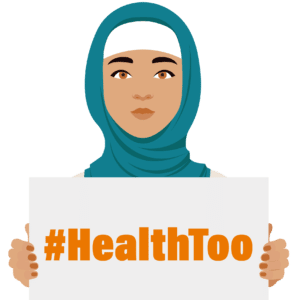The #HealthToo report is published
15 December 2022
 Women in Global Health’s latest policy report Her Story: Ending Sexual Violence and Harassment of Women Health Workers is the culmination of our #HealthToo research project and online platform. It reveals the prevalence of sexual exploitation, abuse and harassment (SEAH) experienced by significant numbers of women health workers.
Women in Global Health’s latest policy report Her Story: Ending Sexual Violence and Harassment of Women Health Workers is the culmination of our #HealthToo research project and online platform. It reveals the prevalence of sexual exploitation, abuse and harassment (SEAH) experienced by significant numbers of women health workers.
In the absence of comprehensive data on SEAH in health, our report uses the testimony of women as data to bring the reality and nature of sexual violence and harassment to life, as well as the conditions that enable it. Women submitted stories to #HealthToo from 40 countries, in ten languages and we have collected accounts through literature and partners from many other countries.
“Personal stories are harder to ignore. They describe the compliance of colleagues, the lack of reporting, fear of reprisal and job loss, the lack of mechanisms for receiving complaints, the absence of laws to prosecute. The testimonies present a clear view of an enabling environment for perpetrators,” said Dr. Roopa Dhatt, Executive Director, Women in Global Health.
Learn more about our work on sexual exploitation abuse and harassment in health.
Although SEAH of women health workers appears to be universal, legal frameworks, cultures and socio-economic contexts vary widely. Action needed to end SEAH in the health workforce must follow broad principles and approaches but be closely tailored to the country context. The proposed solutions below outline approaches and critical points that have emerged from #HealthToo that should be addressed in all contexts.
Solutions
- When the behavior of perpetrators of sexual violence and harassment are sanctioned, then men who choose to sexually abuse women health workers will know for sure that their actions will be made public and the shame and blame will fall on them and not on their victims.
- Organizational leadership is critical. Gender parity in health leadership will drive change but since most perpetrators are men, we should regard SEAH as a men’s problem and not a problem for women to fix. We advocate for all leaders to be gender transformative leaders intentionally addressing gender inequality. Measures to prevent, report and sanction sexual harassment should be included in organizational performance measures and the performance of leaders.
- Listen to women and learn from platforms like #HealthToo. Organizations should take a survivor centered approach to ensure the rights of survivors are clear, well known and that they are protected from retaliation. We must ensure survivors have access to legal, mental health and other services they need to rebuild their lives and careers.
- All countries need to put in place the legal framework to protect women workers. Many countries still lack laws to prohibit work-related sexual harassment. ILO Convention 190, that came into force in 2021, is the first global convention to address work-related violence and harassment. To date only 23 countries have ratified C190. Ratification is a first step for countries to bring their laws in line with a global standard.
- To make this abuse visible, we must set baselines and measure progress. We cannot give figures on prevalence of sexual harassment in the health workforce globally or on most countries because countries and organizations do not collect data routinely or they use different terminology so data is not comparable. International agencies, such as WHO and ILO, should work with member states, women’s organizations, trade unions and professional organizations to set a standard for collecting sex-disaggregated data for the health workforce based on definitions in ILO C190. Then abuse will no longer be invisible.
We hope for five main outcomes from this report
- To end denial about a problem made invisible to policy makers by lack of data (sex disaggregated) and no transparent reporting of cases and their outcomes. We want to put this on the policy table as an issue women talk about and men acknowledge needs to be prevented.
- To encourage women to work collectively through women’s organizations like WGH, trade unions and professional associations to raise this issue as an unacceptable violation of women’s and employment rights. We want to fight the ‘normalization’ of such abuse that women feel they have to manage.
- To encourage men to step up both as organizational leaders to set a culture that doesn’t just state ‘zero tolerance’ but makes that happen. We also want other men to become active bystanders and step in to say that sexual harassment is unacceptable. Everyone needs to own this problem.
- To increase momentum for gender parity in health leadership, recognizing the positive impact of women’s leadership. Women’s marginalization in health leadership (holding 25% senior roles) enables sexual harassment. It is rare for women leaders to perpetrate sexual harassment. Since women are 70% workers in the health sector there is no reason why men should dominate leadership.
- To raise awareness of the costs of sexual harassment of women in the health sector, for women and for health systems. And more, for political decision makers and organizational leaders to recognize the costs of inaction. It does not make human or economic sense to protect a few men who choose to abuse women over protecting women health workers who just want to do their jobs.